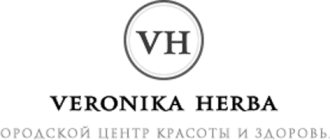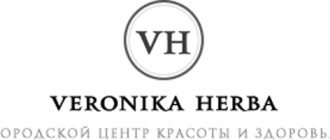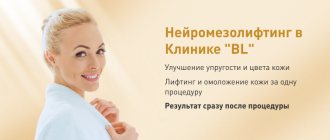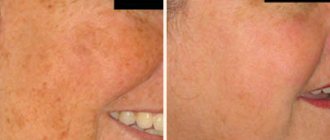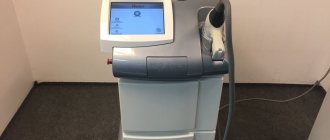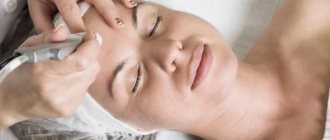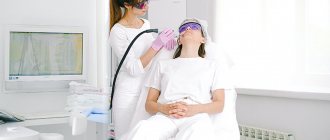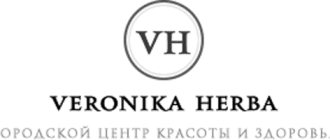When meeting in person with a cosmetologist, you should ask about the cosmetologist’s education and ask for a laser certificate.
It would be a good idea to clarify when the device was last serviced and ask for confirmation that the laser is in order.
The patient should inform the doctor about possible allergic reactions to medications, in particular Panthenol. Before the procedure, the doctor must tell you about contraindications.
Technique
The cosmetologist selects the procedure method, the intensity of radiation, and the treatment area. The client goes through 4 stages:
- Accommodation. The patient lies down on the couch, taking a comfortable position, in which he will spend from 10 to 30 minutes. Hair is removed from the forehead under a disposable cap;
- Facial cleansing. The doctor removes remaining cosmetics, sebum and other contaminants;
- Laser processing. The cosmetologist processes the required areas in scanning mode;
- To reduce redness, a cream with panthenol is applied to the treated area.
Most people experience no pain during the non-ablative rejuvenation process. For a client with sensitive skin, the doctor will provide local anesthesia.
Indications for non-ablative laser rejuvenation
Indications for non-ablative laser rejuvenation include the following problems:
- Porosity and pastiness of the skin;
- “Tired” and haggard appearance of the face;
- Weak manifestations of hyperpigmentation and hyperkeratosis;
- First mimic, mesh or linear wrinkles;
- Loss of turgor and skin tone on the face, neck, and décolleté;
- Dilated subcutaneous vessels;
- Dull complexion;
- Skin dehydration;
- Acne and post-acne.
Prices for non-ablative laser rejuvenation
Depending on the device used in the clinic and the type of radiation source (erbium, neodymium, diode, etc.), the price for laser non-ablative facial skin rejuvenation ranges from 3,500 to 25,000 rubles. The number of recommended procedures is at least three; the full course will cost the client 10.5-75 thousand rubles.
Treatment of the neck and hands is cheaper - from 2,100 to 9,500 (usually these areas cost the same). Neckline area – from 2,500 to 11,000 rubles. The procedure can also be performed on other parts of the body: abdomen, buttocks, thighs, shoulders and arms. A number of clinics offer partial treatment: treatment of the frontal area, nose, facial wrinkles around the eyes.
Many clinics offer a complex: face + décolleté, face plus neck, face + neck + décolleté, etc. Such general anti-aging procedures are cheaper than treating areas separately.
The cost of the service is set by each clinic independently. A significant reduction in price should alert you. There is a possibility that the clinic uses low-quality equipment or does not follow recommendations for replacing consumable parts of the device.
The essence of non-ablative laser rejuvenation
Non-ablative laser rejuvenation is based on the conversion of light energy into heat. Thermal exposure has a beneficial effect on metabolic and biochemical reactions in the cellular and extracellular matrix of the skin. In particular, the process of formation of new collagen fibers, called neocollagenesis, is launched.
With non-ablative laser rejuvenation, tissues are heated to 45-85°C, which is not enough for full ablation (temperature evaporation of liquid), but the process is sufficient to start the process of denaturation and coagulation of the most important proteins in our skin - elastin and collagen. The radiation is absorbed by skin chromophores, and then, bypassing the epidermis, partially penetrates into the dermis, also providing an antibacterial effect.
The main goal of non-ablative laser rejuvenation is to prevent the progression of age-related changes and improve the quality characteristics of the skin. The procedure is recommended for patients aged 25-40 to maintain youthful skin. In some cases, it is prescribed for medical reasons (for example, in the treatment of chronic acne).
For non-ablative laser rejuvenation, various types of lasers are used: neodymium, diode, erbium (erbium glass). The wavelength ranges from 532-1540 nm.
What is fractional photothermolysis and how does it work?
Fractional photothermolysis (ablative laser rejuvenation) is a process of focal tissue destruction by heating it with light (laser) energy.
The effect is due to two phenomena:
Firstly, the old tissue is physically destroyed and removed, in its place a new one, free from the defect, grows;
Secondly, due to heating, skin cells are activated, the phenomenon of so-called “heat shock” occurs, when the cells begin to function like young ones, actively rebuilding the collagen-elastin framework of the skin.
Ultimately, the skin is not only tightened and freed from age spots, but also evened out: scars and wrinkles are smoothed out, stretch marks disappear, pore sizes are reduced, it becomes denser and more elastic.
The visible effect is noticeable after just ONE procedure, and after several, a pronounced rejuvenating result is observed. In addition, there is a good lifting effect for several months after the procedure.
Cosmetical tools
For lifting and rejuvenation with the LaseMD laser, cosmetologists use a series of preparations with different compositions:
- serum with ascorbic acid (VC): vitamin C is considered a natural antioxidant, the composition suppresses the production of melanin, fights active free radicals, removes dead cells, is used to prevent aging, promotes collagen production, and is used to regenerate the upper layers of the epidermis;
- retinol (VA): vitamin A is a real helper for aging skin, it improves structure, enhances cell restoration, rejuvenates cells, saturating them with nutrients;
- tranexamic acid (TA): this substance has been used by cosmetologists for many years to heal scars, scars, wounds after surgical interventions, the composition is used for pigmentation to lighten;
- stem cells (SC): intensive anti-aging composition promotes restoration at the cellular level and also helps fight baldness;
- stem cells with peptides (SC): the drug rejuvenates, stimulates the production of collagen and elastin;
- resveratrol (RS): the composition includes almost pure polyphenol, which, in combination with hyaluronic acid, rejuvenates cells; the drug is used to prevent aging, as a prophylaxis against photoaging.
Advantages of fractional rejuvenation with LaseMD laser:
- thulium fiber laser;
- quick session;
- exact number of effective pulses;
- the beam size is only 100 microns, which ensures comfort during the session;
- painlessness;
- lack of rehabilitation;
- four modes – dynamic, static, random, continuous generation;
- several different attachments;
- short duration of the session.
The procedure is perceived positively by patients, it is well tolerated, and the results justify its price.
What is an ablative fractional laser used for?
Most ablative fractional lasers can be used not only for fractional ablation of the skin surface in order to smooth its relief. Such lasers contain additional modules that allow them to be used for the following tasks: traditional (solid) laser ablation in scanning mode, traditional laser ablation in free-hand mode, excision of soft tissues in dermatosurgery, excision of soft tissues during plastic surgeries, such as blepharoplasty. Many ablative lasers today are also formed by a so-called vulvovaginal rejuvenation module - a special device that allows fractional laser effects not on the skin, but on the vaginal mucosa. Finally, some ablative fractional lasers came into aesthetic medicine from surgery and can be equipped with additional accessories for use in gynecology, laparoscopic surgery, otolaryngology and other areas.
As an example, let’s look at various options for using the ablative superpulse CO2 laser from Lumenis – Acupulse. In the basic configuration, Acupulse is equipped with a fractional laser for deep and superficial fractional ablation, a separate surgical scanner and a set of collimated handles used for various options for continuous ablation and treatment of onychomycosis, layer-by-layer vaporization of tumors, as well as a separate focusing handle used for excision of soft tissue. This set allows Acupulse to perform the full range of ablative procedures in aesthetic medicine and dermatosurgery.
Finally, if there is a task to use Acupulse in other areas of medicine - in surgery, ENT and gynecology, it can be equipped with a variety of accessories: light guides, adapters and robotic beam control systems. It is clear that the presence of the last option is important only if a fractional CO2 laser is purchased for a multidisciplinary medical center. You should also note that to perform a vulvovaginal rejuvenation procedure using a fractional laser, the clinic will need a gynecology license, and the procedure itself must be performed by a gynecologist.
What results should I expect from the procedure?
Non-ablative laser treatments have fewer side effects and less effect from the procedure itself, so multiple treatments may be required to achieve the desired result. An ablative laser can solve your problem in one procedure.
In any case, individual results depend on the nature and size of the initial defects. The result of the procedure may last a year or more, but it is still not permanent and you may have to repeat this procedure after some time.
Contraindications to non-ablative facial and body rejuvenation
- Predisposition to the formation of keloid scars.
- Malignant neoplasms.
- Acute periods of infections.
- Dermatological diseases.
- Some other serious illnesses.
- Having a fresh tan.
- Period of pregnancy or lactation.
Attention! All aesthetic plastic surgeries and most cosmetic procedures are strictly contraindicated for pregnant and lactating women. We also do not perform surgical interventions on people whose weight exceeds 110 kg.
Session results
1-2 days after laser treatment, the skin condition noticeably improves. It acquires an even and fresh shade, lost elasticity returns, small wrinkles and age spots gradually disappear. Active rejuvenation of skin cells has a toning and tightening effect, making the patient look 5-10 years younger.
The effectiveness of the procedure is in no way inferior to the results of plastic surgery. Safety, absence of surgical intervention and postoperative recovery period make this method extremely popular among both women and men.
II FRACTIONAL ABLATIVE LASER + CE FERULIC (SKINCETICALS)
CE Ferulic shortens recovery time after fractional ablative laser treatment and increases basic fibroblast growth factor (bFGF), essential for healing after laser-induced injury
To evaluate the effect of CE FERULIC containing 15% vitamin C, 1% vitamin E and 0.5% ferulic acid (SKINCEUTICALS) on the recovery period after a laser procedure, histological evaluation of bFGF mRNA was performed.
Results Application of CE FERULIC after laser treatment resulted in decreased swelling compared to placebo on day 7 and decreased redness compared to placebo on days 3 and 5. Molecular data showed that bFGF levels were significantly increased on day 5 after CE FERULIC (skin biopsy method).
Protocol: Fifteen participants with moderate photodamage of the skin type II according to the Glogau scale were included in a prospective study approved by the Biomedical Ethics Committee using a double-blind, randomized design (active substance versus placebo). In the study, after the laser treatment, participants treated one half of their face with a serum containing vitamin C, vitamin E and ferulic acid, and the other half received a placebo. Six uninformed researchers rated the photographs as “patient can return to work” and “patient can return to social life.” Five randomly selected patients underwent preauricular biopsies at baseline, 5 days, and 3 months to determine bFGF mRNA levels, and at 3 and 6 months to analyze type I and III collagen by H&E assay. Patients were assessed daily for the first 7 days using photographs and questionnaires.
CE Ferulic demonstrates reduced swelling by Day 3 and reduced downtime by up to 5 days after Fractional Ablative Laser treatment
Assessing the safety and effectiveness of CE Ferulic immediately after a laser procedure to reduce inflammatory markers and promote wound healing
Patient self-assessment: Day 5 “The left half is healing faster than the left [placebo]” Day 6 “The left half looks better”
Protocol: 6 months, 15 patients (12 women, 3 men), 35-55 years old, with visible signs of photoaging. Double-Blind Study: Application of CE Ferulic to one half of the face immediately after a Fractional Ablative CO2 Laser treatment (112 microns deep, 68% density) and Aquaphor® to the other half. After 48 hours, apply CE Ferulic to one half of the face, placebo to the other. Clinical assessment before the procedure and 1,3,5, 7 days after.
CE Ferulic prolongs the results of laser procedures
To evaluate the long-term effectiveness of CE Ferulic, SkinCeuticals antioxidant serum after laser treatments, a prospective clinical study was conducted following skin rejuvenation using fractional ablative laser.
Results: When using the CE Ferulic antioxidant product after the laser procedure, the number of wrinkles after 90 days of the study decreased significantly (by 26%) than on the half of the face treated with placebo (by only 10%). The half of the face treated with the CE Ferulic antioxidant serum showed an improvement in skin tone, Thus, the skin on that side improved by 18%, while the placebo-treated side only improved by 10%.
Protocol: This study, approved by the Biomedical Ethics Commission, included 34 female patients aged 35 to 55 years with Fitzpatrick skin types II–V who underwent a single full-facial laser rejuvenation procedure with the ETHEREA fractional laser (2940 nm, 10 –25 mJ, 8 mm, 3 Hz, 100 mtz/cm, with a pulse width of 1 ms). Immediately after the procedure, a water-based antioxidant serum containing 15% L-ascorbic acid, 1% α-tocopherol, and 0.5% ferulic acid (SkinCeuticals Inc.) was applied to one half of the face of all patients, and the other was treated with a placebo. The facial skin was treated in this way every day for three months. Skin condition (wrinkles, texture, tone) was clinically assessed at baseline, 30, 60 and 90 days after the procedure. Statistical analysis was carried out using descriptive statistics – frequency distribution.
Scheme of SkinCeuticals integrated care with laser treatments based on clinical and scientific research
- Preparation (2 weeks before laser treatment) Apply CE Ferulic antioxidant serum daily in the morning containing 15% pure L-ascorbic acid, 1% vitamin E and 0.5% ferulic acid. It has been proven that CE Ferulic increases the protective function of the skin by 8 times, increasing its immunity and protecting it from the negative effects of poor ecology and the sun.
- In-Office Procedure • Apply CE Ferulic Antioxidant Serum (4-5 drops) immediately after the procedure to speed up pigment removal, stimulate type I collagen synthesis, and reduce redness and speed up the healing process. • Application of soothing masks • For ablative and or non-ablative laser procedures – Individually packaged biocellulose mask (SkinCeuticals) instantly reduces discomfort, cools the skin after invasive procedures, improves and accelerates skin recovery after procedures, creating a hydrophilic protective barrier. • For non-ablative laser treatments, Phyto Corrective Masque for relief of discomfort, immediate comfort and instant noticeable hydration • Application of Triple Lipid Restore 2:4:2 (SkinCeuticals) to restore the skin's lipid barrier and accelerate epithelialization processes. Applying Sheer Mineral UV Defense SPF 50 sunscreen with 100% mineral filters. The product is suitable for sensitive skin and for use after aesthetic procedures.
- Prescribing home care against pigmentation For predicted highly effective results after the procedure, it is extremely important to prescribe home care to the patient. In addition, according to statistics, 96% of patients expect to receive home care appointments after laser procedures. An optimal care program should include 3 mandatory steps: 1. ANTIOXIDANTS, for example CE Ferulic antioxidant serum 2. Corrective agents - Triple Lipid Restore 3. PROTECTION
Conclusion Thus, a comprehensive integrated approach based on SKINCEUTICALS products at the stage of preparation, laser procedures and proper post-procedural care allows you to achieve the best results, for example, CE FERULIC allows you to minimize side effects, shorten the rehabilitation period, increasing the activity of fibroblasts and accelerating the healing time of injuries in the first days after the procedure, enhance pigment removal and prolong the results of laser procedures. Biocellulose mask (SkinCeuticals) in individual packaging instantly reduces discomfort, cools the skin after invasive procedures, improves and accelerates skin recovery after procedures, creating a hydrophilic protective barrier. The combination of treatments, professional SkinCeuticals in-office care immediately after, and daily use of products at home provides excellent long-term results.
1. Waibel J., Beer K., Narurkar V., Alster T. Preliminary observations on fractional ablative resurfacing devices: clinical impressions. J Drugs Dermatol. 8 (2009). 481– 485. 2. Pinnell S. et al. Topical L-Ascorbic Acid: Percutaneous Absorption Studies. Dermatol Surg. 2001; 27(2):137–142. 3. Lin H. et al. Ferulic acid stabilizes a solution of vitamins C and E and doubles its photoprotection of skin. J Invest Dermatol. 2005;125(4):826–32.
Magazine, “Oblik. Esthetic guide", 2022
If you have any questions or make an appointment with a cosmetologist, please call:
+7 (495) 255−50−11.
Laser ablation in cosmetology
Laser ablation in cosmetology is a technique in which a laser beam penetrates into the very depths, is absorbed by the liquid and gradually evaporates it. But one part of the natural skin tissue is removed. Ablation usually occurs at high temperatures above 150°C.
The laser greatly damages the skin in order to result in natural restoration, the production of new collagen cells, and the elastin fibers are strengthened. Instead of destroyed cells, new ones will appear to replace them. There are options for laser treatments: ablative and non-ablative. The first option spoils the structure of the building, the non-ablative option is the opposite.
The result of non-ablative laser rejuvenation
The result of non-ablative laser rejuvenation will be a number of positive changes:
- Narrowing and reduction of pores;
- Uniformity of skin microrelief;
- Fresh, uniform, beautiful skin tone;
- Increased elasticity and contractility of the skin;
- Smoothing shallow skin creases;
- Softness, velvety, matte skin.
Non-ablative laser rejuvenation is suitable for those who want to protect themselves from early aging and for those who are contraindicated for more aggressive laser procedures. The key condition for achieving visible effects of non-ablative laser rejuvenation is following the quantitative and interval scheme of procedures selected by the cosmetologist.
What is the essence of non-ablative fractional skin rejuvenation?
The mechanism of action of non-ablative rejuvenation is based on the principle of fractional photothermolysis:
- “FRACTIONAL” - the effect on the skin is not carried out by a full laser beam of a certain diameter, but fragmentarily (microzonally), creating thermal coagulation channels at different depths of the dermis (depending on the type of laser);
- “PHOTO” - pulsed light energy supply;
- “THERMO” is the thermal effect of a laser beam on water, which is contained in various skin structures. Interstitial and interstitial fluid is dosed to 60 °C, diffusely distributing heat to surrounding tissues. At the same time, the skin structures are exposed to thermal stress, due to which the processes of neocollagenogenesis are launched and metabolic reactions are activated;
- “LYSIS” - as a result of such thermal exposure, denaturation and lysis of old, “spent” areas of collagen—the framework proteins of the dermis—occurs, which triggers the processes of their renewal and restructuring.
After such rejuvenation procedures, tissue regeneration and restoration are carried out simultaneously at three levels: on the skin surface, in the middle and deep layers of dermal tissue between coagulation thermal channels.
Fractional impact technologies and technical possibilities for their implementation
Cosmetologists at our clinic in Moscow carry out skin rejuvenation procedures using fractional non-ablative techniques using two modern professional machines from the world's leading manufacturers.
What they are and their main advantages:
- The FOTONA SP Dynamis laser platform is an erbium laser with a wavelength of 2940 nm and a unique patented Smooth technology. The laser tissue capture depth is up to 1000 microns (1.2 mm). Thanks to Fotona's innovative engineering solutions, the laser makes it possible to carry out an effect (perform a procedure) not only on the surface of the skin, but also on the mucous membranes - these are procedures for the treatment of snoring, 4D facial rejuvenation, vaginal rejuvenation, non-surgical blepharoplasty, etc.;
- Modular multifunctional system Palomar Star Lux 500 with two attachments - laser and pulsed light radiation for fractional (islet) skin rejuvenation, with the help of which not only the elimination of wrinkles is carried out, but also the alignment of stretch marks, scars and scars after acne, therapy and correction of sagging and " laxity of the skin, etc.;
- The Palomar 1540 attachment is an erbium fractional laser with a penetration depth of up to 1.4 mm, providing a superficial fractional effect on the skin.
- The Palomar Deep IR attachment is an infrared pulsed light emitter, with an exposure depth of up to 7 mm, i.e. The laser works at the level of the deep layers of the dermis, without damaging the surface of the patient’s skin at all. The main function of this laser is thermal stimulation of the basal (growth) layer of the dermis in order to launch the processes of synthesis of new collagen.
After several procedures of complex fractional non-ablative rejuvenation using the laser attachment Palomar DeepIR and Palomar 1540, results are guaranteed in increasing elasticity and turgor, reducing sagging and sagging skin of the abdomen, arms and legs, as well as removing wrinkles around the eyes, in the eyelid area, on the face, neck and décolleté area - this is confirmed by patient reviews.
Advantages of fractional laser rejuvenation using a non-ablative technique
The main effect of rejuvenation, improvement of skin quality and tightening as a result of non-ablative rejuvenation procedures is achieved through renewal, restructuring, tightening of dermal structures and triggering the synthesis of the main framework proteins of the dermis - collagen and elastin.
The great popularity of fractional photothermolysis, and most importantly the effectiveness of the procedures, was ensured by the unique combination of advantages of the technique in the conditions of our medical center:
- wide range of indications;
- high efficiency of procedures in our clinic due to the presence of three lasers within one technique;
- complete safety due to the professional level of both equipment and specialists;
- the possibility of influencing a variety of areas of the skin and mucous membranes (breasts, eyelid area, mucous membranes of the oral cavity and vagina, etc.);
- quick (short) rehabilitation (no damage to the surface layer of the skin) and the ability to return to everyday life the very next day;
- the procedures do not require pain relief, the patient feels a slight tingling and warmth in the affected areas during treatment;
- do not leave traces on the skin in the form of microholes. All that awaits the patient is redness and, as a rule, slight swelling, and these effects usually last no more than two to three days;
- procedures are carried out at any time of the year, regardless of the season.
How does the fractional laser rejuvenation procedure work in our clinic?
At the beginning of your appointment, the doctor will conduct a visual examination of the condition of your skin, ask about contraindications and find out about the medications you are currently taking. It is extremely important to tell your doctor about the medications you are currently taking before starting the procedure, as some of them may cause unwanted side effects.
The procedure begins with the doctor applying a local numbing agent to the skin to reduce discomfort from photothermolysis. After approximately 40 minutes, the anesthesia is removed and the procedure begins, where the doctor slowly moves the laser handle over the face. After the session, the doctor applies a special product to the face that protects and restores the skin.
As with any other medical cosmetic procedures, after laser rejuvenation there are risks of side effects. But if you strictly follow your doctor's recommendations, this risk will be minimized.
Legato device (Pixel RF)
This is a unique method of exposure, without the use of a laser, with the possibility of fractional skin resurfacing and the simultaneous introduction of medicinal substances into the deep layers of the skin.
Legato therapy involves the use of radiofrequency energy based on the new fractional microplasma technology iPixel RF. The unique Pixel RF module produces an ablative effect, causing microscopic perforations with a zone of thermal damage.
The procedure allows you to renew the skin and improve its quality, obtaining a pronounced lifting effect comparable to surgical skin tightening without long-term rehabilitation. And also get rid of wrinkles, stretch marks, unwanted scars, in particular after acne (post-acne), age spots, make your skin denser, more elastic and toned.
Unique Impact iTED nozzle . iTED (Trans Epidermal Delivery) – trans-epidermal delivery of a medicinal/cosmeceutical product.
Ultrasound technology, patented by Alma Lasers, alternates positive and negative acoustic pressure, which makes it possible to deliver medications into the skin using ultrasonic acoustic vibrations.
Using Impact immediately after ablative resurfacing makes it possible to help the skin recover as quickly as possible and avoid infection and other complications by filling the perforated skin with therapeutic substances with anti-inflammatory, regenerating, pigmentation-regulating and vascular-strengthening properties.
The attachment was specially designed for combined use with microplasma and laser fractional resurfacing procedures.
Duration of procedure: 30-90 minutes
Recovery period: from 7 to 10 days
Due to the specific features of the effect on the skin, our clinic specialists select the most optimal method of rejuvenation in each specific case, taking into account the location of the problem, age and other characteristics.
Types of non-ablative laser rejuvenation
Non-ablative laser rejuvenation can be carried out using a continuous or fractional method. In the first case, the effect is carried out on the entire surface of the skin, and in the second, the laser affects certain points (fractions). The specific type of procedure is selected by the cosmetologist based on the indications and initial data.
Non-ablative laser rejuvenation is atraumatic in any case. The surface layer of the skin is not subject to destruction or destruction, so there is no rehabilitation period. The rejuvenating effect of the procedure appears gradually and has a tendency to accumulate. The goal of non-ablative laser rejuvenation is gradual dermal remodeling.
A relative disadvantage of non-ablative laser rejuvenation is the need to undergo a full cycle of procedures. Typically, to achieve good results, 3 to 10 sessions are required with a time interval of 10-30 days. When treating acne/post-acne, this course of therapy allows you to achieve the best results.
Rehabilitation is simple, so the patient does not feel the typical discomfort and need for long-term recovery.
The essence of the procedure
Effects on the skin can be non-ablative and ablative. In the first case, the skin is not injured, the dermis warms up, which leads to the synthesis of collagen and elastin.
With ablative treatment, the integrity of the skin is compromised. The impact can be complete - laser resurfacing is carried out, or incomplete - thermolysis is carried out with a fractional laser.
The use of the ablative method involves the use of a carbon dioxide or erbium laser. The radiation affects the upper layers of the dermis to eliminate such nuances as wrinkles and scars, creases around the eyes, and hyperpigmentation. Ablative laser allows you to eliminate stretch marks and scars. After such rejuvenation, a short recovery is required.
I FRACTIONAL NON-ABLATIVE LASER + CE FERULIC (SKINCEUTICALS)
Replenishment of vitamin C deficiency after laser procedure
CE FERULIC penetration is increased 17 times after fractional non-ablative laser to support and accelerate the healing process.
Protocol: Skin biopsy (Freshly excised ex-vivo tissue), ex-vivo was treated with fractional non-ablative laser Clear + Brilliant® Perméa™ with a pulse energy of 5 mJ and a wavelength of 1927 nm, with a coverage of 5%, 7.5% and 10 %. Application of CE Ferulic antioxidant serum (SkinCeuticals).
CE Ferulic speeds up the rehabilitation process
Reduces redness after fractional non-ablative laser treatment by 18%.
Protocol: 12 weeks, 18 patients (men and women, 35-60 years, Fitzpatrick I-IV), single treatment of forearm skin with fractionated low energy non-ablative laser (wavelength 1927nm, pulse energy at 5 mJ and 5-10% coating). Apply CE Ferulic immediately after the procedure. Skin biopsies were taken from 10 of 18 patients.
CE Ferulic enhances pigment clearance after fractional non-ablative laser
Protocol: 1 day after the procedure, Fontana-Masson staining shows the release of melanin (colored black) through the epidermis into microscopic epidermal necrotic debris (MENDs) for further exfoliation. (Blue markers indicate migration of pigmented cells into the MENO.) 14 days after the procedure, the epidermis overlying the MTZ remained without pigment, while the adjacent areas exhibited pigment in the underlying membrane.
Recovery period
The complications or consequences of the procedure typical for laser peelings and resurfacing are practically not felt with non-ablative laser rejuvenation. In the first 1-2 days, slight redness and increased skin temperature are possible. Then these signs disappear, without even leaving behind peeling.
Rehabilitation after non-ablative laser rejuvenation does not require restrictions or therapeutic manipulations from the patient, however, the cosmetologist should give you recommendations to consolidate the effect obtained. Non-ablative laser rejuvenation can be safely classified as a “lunch break” procedure - immediately after its completion, the patient can return to normal activities and interact with people without being embarrassed about their appearance.
It should be understood that non-ablative laser rejuvenation is essentially a therapeutic, too soft and “gentle” procedure, so it is naive to expect an effect comparable to that of a surgical lift. The procedure is suitable for maintaining facial skin in a healthy and youthful state, but does not provide global anti-age results. For patients with obvious sagging and ptosis of the skin, dark and heavy pigmentation, loose wrinkles and folds, classic laser resurfacing or “fractional resurfacing” - procedures with an ablative effect - are more suitable.
Indications and contraindications
The non-ablative laser rejuvenation procedure is ideal for:
- elimination of visible age-related changes in the skin - wrinkles, folds, sagging, dryness;
- removal of pigment spots;
- improving complexion;
- correction of keloid scars;
- fight acne, etc.
Laser rejuvenation is not performed if the patient has any of the following contraindications:
- oncological diseases;
- inflammatory processes on the skin;
- exacerbation of a chronic disease;
- pregnancy and lactation;
- immunodeficiency, etc.
The decision to perform a laser rejuvenation procedure is made by a specialist after examining the patient.
Non-ablative
Non-ablative laser rejuvenation uses low-energy rays. They improve the condition of the skin from the inside without affecting its surface layers. The soft action of the light flux allows the use of this type of rejuvenation on all parts of the body.
Operating principle and result
The mechanism of operation of a non-ablative laser is based on heating followed by tissue coagulation and selective destruction of unusable protein fibers.
After the sessions, the subcutaneous structures of the treated areas become denser, natural self-healing processes are launched, and new collagen is produced for the construction of a full-fledged membrane frame.
The result of non-ablative treatment:
- improvement of cellular metabolism;
- tightening the skin, restoring its elasticity and firmness:
- removal of the first static wrinkles;
- elimination of signs of hyperkeratosis, subcutaneous vascular pathologies;
- narrowing of pores.
Advantages and disadvantages
The advantages of the technique include:
- Almost complete absence of complications.
- Short recovery period.
- There is no seasonality of the procedure or age restrictions.
- Intensive production of collagen and elastane.
- Comfort of carrying it out.
Disadvantages of technology:
- Serious cosmetic problems require several courses of procedures, with long intervals between them.
- Not always showing effect after the first procedure.
Indications and contraindications for non-ablative resurfacing
Non-ablative laser is indicated for use in:
- initial age-related skin problems;
- the presence of pigmented, stagnant spots, manifestations after acne;
- decreased overall tone, drooping tissue, uneven terrain;
- withering of the skin, loss of its elasticity.
Contraindications for use are:
- dermatitis, psoriatic rashes, herpes;
- oncological processes;
- blood diseases, poor coagulability;
- diseases of the endocrine system;
- severe heart pathologies.
Skin lifting technique
The procedure using a non-ablative laser beam is carried out on an outpatient basis and begins with a preparatory period, during which the skin is treated with special compounds. During the session, no anesthesia is required; the procedure is carried out using a contact cooling system. You can find out about gas-liquid mesotherapy here.
Stages of laser correction
The laser procedure is painless, in a calm, relaxed atmosphere. The cosmetologist places the patient on the couch and begins the session. He does not use painkillers, cooling gels or anesthetics. The doctor sets up the device and selects the attachment depending on the purpose of use.
The cosmetologist selects the number of sessions for each patient individually. For minor wrinkles, acne or pigmentation, one session may be sufficient. In some cases, a course of therapy of 4-6 procedures is required. Between sessions there is a break of 2-3 weeks. The procedure with the device can be prescribed at any age, regardless of season or skin type.
What is fractional laser skin resurfacing or laser drilling?
The essence of the fractional ablative laser rejuvenation method is that micro areas of the skin are removed (evaporated) using a laser, which are replaced by renewed tissue and tightened during the healing process.
This laser effect on the skin provides a significant reduction in the skin flap and an amazing lifting (tightening) effect; smoothing out wrinkles, even the deepest ones; removal of scar tissue and smoothing of skin texture.
Fractional ablative lasers during the procedure create a matrix of many microbeams, the penetration depth of which can vary from 1 to 8 mm to affect both the superficial and deep layers of the dermis. The following happens:
- superficial action ensures the evaporation of pathologically altered tissues (scars, wrinkles, etc.) and the reduction of excess sagging skin;
- deep impact triggers the processes of structural renewal of the skin and underlying dermal tissues and enhances cell regeneration with the formation of new collagen.
